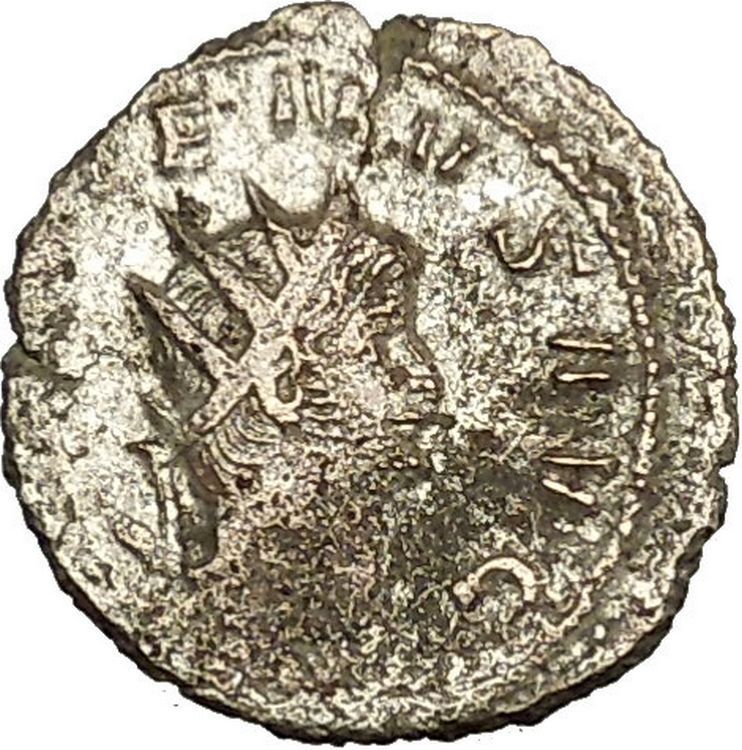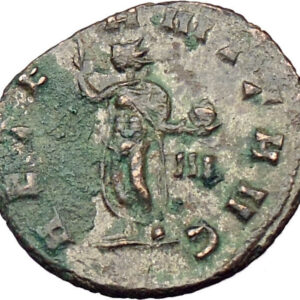|
–
Roman Emperor
: 260-268 A.D.
Silver Antoninianus 23mm (3.40 grams) Treveri (Trier) mint, 268 A.D.
Reference: RIC V 309; Mairat 149-53; AGK 38a; RSC 159a
IMP C POSTVMVS P F AVG, Radiate, draped, and cuirassed bust right.
IOVI STATORI, Jupiter standing facing, head right, holding scepter and
thunderbolt. .
You are bidding on the exact
item pictured, provided with a Certificate of Authenticity and Lifetime
Guarantee of Authenticity.
In
Roman mythology
,
Jupiter
or Jove was the
king of the gods
, and the god of
sky
and thunder
. He is
 the
the
equivalent of Zeus
in the
Greek pantheon
. He was called Iuppiter
(or Diespiter) Optimus Maximus (“Father God the Best and
Greatest”). As the patron deity of
ancient Rome
, he ruled over laws and social
order. He was the chief god of the
Capitoline Triad
, with sister/wife
Juno
. Jupiter is also the father of the god
Mars
with Juno. Therefore, Jupiter is the
grandfather of
Romulus and Remus
, the legendary founders of
Rome. Jupiter was venerated in
ancient Roman religion
, and is still venerated
in
Roman Neopaganism
. He is a son of
Saturn
, along with brothers
Neptune
and
Pluto
. He is also the brother/husband of
Ceres
(daughter of Saturn and mother of
Proserpina
), brother of
Veritas
(daughter of Saturn), and father of
Mercury
.
Marcus Cassianius Latinius Postumus was a Roman emperor of
Batavian
origin. He usurped power from
Gallienus
in 260 and formed the so called
Gallic Empire
. He was recognized in Gaul, Germania, Britannia and Iberia
until his murder in 268.
//
Rise to power
Little is known about the early life of Postumus, but it is believed that he
was a
Batavian
of humble origins who rose through the ranks of the army,
eventually becoming the governor of
Germania Superior
or
Inferior
. While
Gallienus
was dealing with problems in the east, he left his son,
Saloninus
,
and military commanders, including Postumus, to protect the
Rhine
. Amid the
chaos of an invasion by the
Alamanni
and Franks
,
Postumus was declared emperor. Postumus then besieged and attacked
Cologne
where
Silvanus
, praetorian prefect and former co-director of Roman policy on Gaul
(along with Postumus) had sided with Saloninus. After breaching the walls of the
city, Postumus had Silvanus and Saloninus killed; later he erected a triumphal
arch to celebrate his victory.
Rule
Postumus was recognized as emperor in Gaul,
Hispania
,
Germany, and Britain. He set up the capital of his empire at
Cologne
,
complete with its own senate, consuls and praetorian guard. He represented
himself as the restorer of Gaul on some of his coins, a title he earned after
successfully defending Gaul against the Germans. The coins issued by Postumus
were of better workmanship and higher precious metal content than coins issued
by Gallienus.
In 263, Gallienus launched a campaign to defeat Postumus. After initial
success against him, Gallienus was seriously wounded and needed to return home.
After his failed attempt at defeating Postumus, Gallienus was occupied with
crises in the rest of his empire and never challenged Postumus again.
Aureolus
,
a general of Gallienus who was in command of
Milan
, openly
changed sides and allied himself with Postumus. The city of Milan would have
been critical to Postumus if he planned to march on Rome. For whatever reason,
Postumus failed to support Aureolus, who was besieged by Gallienus.
Postumus was himself challenged by a usurper in 268, one of the many
so-called
Gallienus usurpers
of the period.
Laelianus
,
one of Postumus’ top military leaders, was declared emperor in
Mainz
by the
local garrison and surrounding troops (Primigenia Legio
XXII ). Although Postumus was able to quickly capture Mainz
and kill Laelianus, he was unable to control his own troops and they turned on
him and killed him, since they were dissatisfied with him for not allowing them
to sack the city of Mainz (Aur.
Vict. 33.8;
Eutrop.
9.9.1).
Following the death of Postumus, his empire lost control of Britain and
Spain, and the shrunken remains of the
Gallic Empire
were inherited by
Marcus Aurelius Marius
Postumus is listed among the
Thirty Tyrants
in the
Historia Augusta
. Although his reign is often listed as beginning in 259, it
is now believed that the summer or fall of 260 is the more likely date that he
was hailed emperor. This topic is still debated. If the date of 260 is chosen
for the start of Postumus’ reign, then all of the subsequent dates involving the
Gallic Empire are pushed forward by one year.
The Gallic Empire (Latin:
Imperium Galliarum) is the modern
name for a breakaway part of the
Roman Empire
that functioned de facto as
a separate state from 260 to 274.It originated during the
Crisis of the Third Century
.
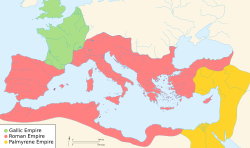
Tetricus I
by 271 A.D. (in green)
It was established by
Postumus
in 260 in the wake of
barbarian
invasions and instability in
Rome, and at its height included the territories of
Germania
,
Gaul
,
Britannia
, and (for a time)
Hispania
. After Postumus’ assassination in 268
it lost much of its territory, but continued under a number of emperors and
usurpers. It was retaken by
Roman emperor
Aurelian
after the
Battle of Châlons
in 274.
History
Origins
The Roman
Crisis of the Third Century
continued as
Emperor
Valerian
was defeated and captured by the
Sassanid Empire
of
Persia
, leaving his son
Gallienus
in very shaky control. Shortly
thereafter, the
Palmyrene Empire
, which came to encompass
Egypt
,
Syria
,
Judea
, and
Arabia Petraea
also broke away.
The governors in
Pannonia
staged unsuccessful local revolts. The
Emperor left for the Danube to attend to their disruption. This left
Postumus
, who was governor of
Germania Superior
and
Inferior
, in charge at the Rhine border. An
exeptional administrator, Postumus had also protected the Germania Inferior
against an invasion led by the Franks in the summer of 260 very well. In fact,
Postumus defeated the Frankish forces at Empel so decisively, that there would
be no further Germanic raids for 10 years. This all would have combined to make
Postumus one of the most powerful men in the west of the Roman empire.
The imperial heir
Saloninus
and the praetorian prefect Silvanus
remained at Colonia Agrippina (Cologne),
to keep the young heir out of danger and perhaps also as a check on Postumus’
ambitions. Before long, however, Postumus besieged Colonia Agrippina and put the
young heir and his guardian to death, making his revolt official. Postumus is
thought to have established his capital at Cologne or Trier,[2]
with Lugdunum also becoming an important city in the empire.
The Gallic Empire had its own praetorian guard, two annually elected consuls
(not all of whose names have survived) and probably its own senate. According to
the numismatic evidence, Postumus himself held the office of consul five times.
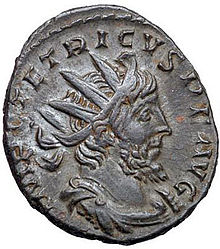
Coin of
Tetricus
, last emperor (271–274) of
the Gallic Empire
Postumus successfully fended off a military incursion by Gallienus in 263,
and was never challenged by him again. However, in early 268 he was challenged
by Laelianus
, probably one of his commanders, who
was declared emperor at Mogontiacum (Mainz)
by his
Legio XXII Primigenia
. Postumus quickly retook
Mogontiacum and Laelianus was killed. Postumus himself, however, was overthrown
and killed by his own troops, reportedly because he did not allow them to sack
the city.[3][4]
After Postumus
After the death of Postumus, the Gallic Empire began to decline. Roman
Emperor
Claudius Gothicus
re-established Roman
authority in
Gallia Narbonensis
and parts of
Gallia Aquitania
, and there is some evidence
that the provinces of Hispania, which did not recognize the subsequent Gallic
Emperors, may have re-aligned with Rome then.[5][6]
Marius
was instated as Emperor upon Postumus’
death, but died very shortly after; ancient sources writing much later state
that he reigned only two days, though it is more likely, as displayed through
the numismatic record, that he reigned for a few months.[7]
Subsequently
Victorinus
came to power, being recognized as
Emperor in northern Gaul and Britannia, but not in Hispania.[5]
Victorinus spent most of his reign dealing with insurgencies and attempting to
recover the Gaulish territories taken by Claudius Gothicus. He was assassinated
in 271, but his mother
Victoria
took control of his troops and used
her power to influence the selection of his successor.[5]
With Victoria’s support,
Tetricus
was made Emperor, and was recognized
in Britannia and the parts of Gaul still controlled by the Empire.[8]
Tetricus fought off Germanic barbarians who had begun ravaging Gaul after the
death of Victorinus, and was able to re-take Gallia Aquitania and western Gallia
Narbonensis while Roman Emperor
Aurelian
was engaging Queen
Zenobia
‘s
Palmyrene Empire
in the east. He established
the imperial court at Trier
, and in 273 he elevated his son,
also named Tetricus
, to the rank of
Caesar
. The following year the younger Tetricus
was made co-consul, but the Empire grew weak from internal strife, including a
mutiny led by the usurper
Faustinus
.[8]
By that time Aurelian had defeated the Palmyrene Empire and had made plans to
re-conquer the west. He moved into Gaul and defeated Tetricus at the
Battle of Châlons
in 274; according to some
sources, Tetricus offered to surrender in exchange for clemency for him and his
son before the battle.[8]
This detail may be later propaganda, but either way, Aurelian was victorious,
and the Gallic Empire was effectively dismantled.[8]
Causes
The Gallic Empire was symptomatic of the fragmentation of power during the
third-century crisis. It has also been taken to represent autonomous trends in
the western provinces, including proto-feudalistic tendencies among the Gaulish
land-owning class whose support has sometimes been thought to have underpinned
the strength of the Gallic Empire, and an interplay between the strength of
Roman institutions and the growing salience of provincial concerns.[10]
One of Postumus’ primary objectives as emperor was evidently the defence of the
Germanic frontier; in 261 he repelled mixed groups of
Franks
and
Alamanni
to hold the Rhine
limes
secure (though lands beyond the upper
Rhine and Danube had to be abandoned to the barbarians within a couple of
years). In so doing, Postumus positioned himself avowedly as not only the
defender and restorer of Gaul, but also as the upholder of the Roman name.
The usurpation of power over Britain and northern Gaul by
Carausius
just twenty years later reflects a
continuing trend by which local loyalties from the landed aristocracy and
deteriorating morale in the legions enabled Carausius to seize power in Britain.[citation
needed] Similarly with the withdrawal of legions
after 408, many Britons desired a localized Roman authority rather than
nationalist revolt. The desire for Roman order and institutions was entirely
compatible with a degree of national or regional separatism.
Gallic Emperors
The Gallic Emperors are known primarily from the
coins they minted. The political and military history of the Gallic
Empire can be sketched through the careers of these emperors. Their names are as
follows:
- Postumus
260–268- (Laelianus
268, usurper)
- (Laelianus
-
Marius
268 - Victorinus
268–270- (Domitianus
271? usurper)
- (Domitianus
- Tetricus the elder
[14]
270–274-
Tetricus the younger
270–274 (son of
Tetricus;
caesar
)
-
Tetricus the younger
Consuls of the
Gallic Empire
| Year | Consul | Consul |
|---|---|---|
| 260 | Postumus (second time) |
unknown |
| 261 | Postumus (third time) | |
| 262 | unknown | |
| 263 | ||
| 264 | ||
| 265 | Postumus (fourth time) | |
| 266 | ||
| 267 | unknown | |
| 268 | Postumus (fifth time) |
Victorinus (first time) |
| 269 | unknown | unknown |
| 270 | Victorinus (second time) | Sanctus |
| 271 |
Tetricus (first time) |
unknown |
| 272 | Tetricus (second time) | |
| 273 | Tetricus (third time) | |
| Year and sequence unknown: | ||
| ? | Censor (twice) | Lepidus (twice) |
| ? | Dialis | Bassus |
| ? | “Apr.” | “Ruf.” |
The Principate
Julio-Claudian
dynasty
|
|
|
|
|
|
|
|
|
|
|
|
|
|
|
|
|
|
|
|
|
|
|
|
Year
of the Four Emperors (Civil War)
|
|
|
|
|
|
|
|
|
|
|
|
|
|
|
|
Flavian
dynasty
|
|
|
|
|
|
|
|
|
|
|
|
|
|
|
|
Nervan-Antonian
dynasty
Main article:
Five Good Emperors
|
|
|
|
|
|
|
|
|
|
|
|
|
|
|
|
|
|
|
|
|
|
|
|
|
|
|
|
|
|
|
|
|
|
|
|
Year
of the Five Emperors &
Severan dynasty
|
|
|
|
|
|
|
|
|
|
|
|
|
|
|
|
|
|
|
|
|
|
|
|
|
|
|
|
|
|
|
|
|
|
|
|
|
|
|
|
|
|
|
|
|
|
|
|
Rulers during the
Crisis of the Third Century
|
|
|
|
|
|
|
|
|
|
|
|
|
|
|
|
|
|
|
|
|
|
|
|
|
|
|
|
|
|
|
|
|
|
|
|
|
|
|
|
|
|
|
|
|
|
|
|
|
|
|
|
|
|
|
|
|
|
|
|
|
|
|
|
|
|
|
|
|
|
|
|
|
|
|
|
|
|
|
|
|
|
|
|
|
|
|
|
|
|
|
|
|
|
|
|
|
|
|
|
|
|
|
|
|
|
|
|
|
|
|
|
|
|
|
|
|
|
|
|
|
|
|
|
|
|
|
|
|
|
|
|
|
|
|
|
|
|
|
|
|
|
|
|
|
|
|
|
|
|
|
|
|
|
|
|
|
|
|
|
|
|
|
|
|
|
|
|
|
|
|
|
Gallic
Empire
260
to 274
|
|
|
|
|
|
|
|
|
|
|
|
|
|
|
|
|
|
|
|
|
|
|
|
|
|
|
|
Britannic
Empire
286
to 297
|
|
|
|
|
|
|
|
|
|
|
|
Dominate
Tetrarchy
and
Constantinian dynasty
|
|
|
|
|
|
|
|
|
|
|
|
|
|
|
|
|
|
|
|
|
|
|
|
|
|
|
|
|
|
|
|
|
|
|
|
|
|
|
|
|
|
|
|
|
|
|
|
|
|
|
|
|
|
|
|
|
|
|
|
|
|
|
|
|
|
|
|
|
|
|
|
|
|
|
|
|
|
|
|
|
|
|
|
Valentinian
dynasty
|
|
|
|
|
|
Valentinian I Coins.htm |
|
|
|
|
|
|
|
|
|
|
|
Gratian Coins.htm |
|
|
|
Valentinian II Coins.htm |
|
|
|
Magnus Maximus Coins.htm |
|
|
|
Flavius Victor Coins.htm |
|
|
|
Eugenius Coins.htm |
|
Theodosian
dynasty
|
|
|
|
|
|
Theodosius I Coins.htm |
|
|
|
Arcadius Coins.htm |
|
|
|
Honorius Coins.htm |
|
|
|
Constantine III Coins.htm |
|
|
|
Constans II Coins.htm |
|
|
|
Priscus Attalus Coins.htm |
|
|
|
Maximus Coins.htm |
|
|
|
Jovinus Coins.htm |
|
|
|
Sebastianus Coins.htm |
|
|
|
Theodosius II Coins.htm |
|
|
|
Constantius III Coins.htm |
|
|
|
Johannes Coins.htm |
|
|
|
Valentinian III Coins.htm |
|
Western
Roman Empire
|
|
|
|
|
|
Petronius Maximus Coins.htm |
|
|
|
Avitus Coins.htm |
|
|
|
Majorian Coins.htm |
|
|
|
Libius Severus Coins.htm |
|
|
|
Anthemius Coins.htm |
|
|
|
Olybrius Coins.htm |
|
|
|
Glycerius Coins.htm |
|
|
|
Julius Nepos Coins.htm |
|
|
|
Romulus Augustus Coins.htm |
|
Further information:
Barbarian kings of Italy
Eastern
Roman Empire
-
For
the rulers of the Eastern Roman Empire (also known as the
Byzantine Empire
) after
Theodosius II
, see:
List of Byzantine Emperors
Theodosian dynasty (395–457)
Theodosian dynasty
| Name | Reign | Comments | |
|---|---|---|---|
|
Theodosius I “the Great” (Θεοδόσιος Α’ ο Μέγας, Flavius Theodosius)Theodosius I Coins.htm |
19 January 379 – 17 January 395 |
Born on 11 January 347. Aristocrat and military leader, brother-in-law of Gratian, who appointed him as emperor of the East. From 392 until his death sole Roman emperor |
|
|
Arcadius (Αρκάδιος, Flavius Arcadius)Arcadius Coins.htm |
17 January 395 – 1 May 408 |
Born in 377/378, the eldest son of Theodosius I. Succeeded upon the death of his father |
|
|
Theodosius II (Θεοδόσιος Β’, Flavius Theodosius) Theodosius II Coins.htm |
1 May 408 – 28 July 450 |
Born on 10 April 401, the only son of Arcadius. Succeeded upon the death of his father. As a minor, the praetorian prefect Anthemius was regent in 408–414. He died in a riding accident |
|

|
Marcian (Μαρκιανός, Flavius Valerius Marcianus) Marcian Coins.htm |
450 – January 457 | Born in 396. A soldier and politician, he became emperor after being wed by the Augusta Pulcheria , Theodosius II’s sister, following the latter’s death. Died of gangrene |
Leonid
dynasty (457–518)
House of Leo
| Name | Reign | Comments | |
|---|---|---|---|
|
Leo I “the Thracian” (Λέων Α’ ο Θράξ, Flavius Valerius Leo) Leo I Coins.htm |
7 February 457 – 18 January 474 |
Born in Dacia in 401. A common soldier, he was chosen by Aspar , commander-in-chief of the army. Died of dysentery |
|
-coin.jpg/80px-Leo_(474)-coin.jpg)
|
Leo II (Λέων Β’, Flavius Leo) Leo II |
18 January – 17 November 474 |
Born in 467, the grandson of Leo I. Succeeded upon the death of Leo I. Died of an unknown disease, possibly poisoned |

|
Zeno (Ζήνων, Flavius Zeno) Zeno Coins.htm |
17 November 474 – 9 April 491 |
Born c.425 at Zenonopolis , Isauria , originally named Tarasicodissa. Son-in-law of Leo I, he was bypassed in the succession because of his barbarian origin. Named co-emperor by his son on 9 February 474, he succeeded upon the death of Leo II. Deposed by Basiliscus, brother-in-law of Leo, he fled to his native country and regained the throne in August 476. |

|
Basiliscus (Βασιλίσκος, Flavius Basiliscus) Basiliscus Coins.htm |
9 January 475 – August 476 |
General and brother-in-law of Leo I, he seized power from Zeno but was again deposed by him. Died in 476/477 |
.jpg/80px-Anastasius_I_(emperor).jpg)
|
Anastasius I (Αναστάσιος Α’, Flavius Anastasius)
BYZANTINE – Anastasius |
11 April 491 – 9 July 518 |
Born c. 430 at Dyrrhachium , Epirus nova . A palace official (silentiarius) and son-in-law of Leo I, he was chosen as emperor by empress-dowager Ariadne |
Justinian Dynasty
Justinian Dynasty
| Portrait | Name | Born | Reigned | Succession | Died |
|---|---|---|---|---|---|
|
|
Justin I FLAVIVS IVSTINVS AVGVSTVS |
c. 450 AD, Naissus |
July 9, 518 AD – August 1, 527 AD | Commander of the palace guard under Anastasius I) ; elected as emperor with support of army |
August 1, 527 AD Natural causes |
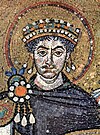
|
Justinian I FLAVIVS PETRVS SABBATIVS IVSTINIANVS AVGVSTVS |
c. 482 AD, Tauresium , Dardania |
August 1, 527 AD – 13/14 November 565 AD | Nephew and nominated heir of Justin I |
13/14 November 565 AD Natural causes |
|
|
Justin II FLAVIVS IVSTINIVS IVNIOR AVGVSTVS |
c. 520 AD, ? | 13/14 November 565 AD – 578 AD | Nephew of Justinian I |
578 AD Became insane; Tiberius II Constantine ruled as regent from December 574 and became emperor on Justin’s death in 578 |
Roman Late Monogram Coins.htm
Roman AE4 Coins.htm
See also
-
Roman Republic
-
Roman Empire
-
Western Roman Empire
-
Byzantine Empire
-
Britannic Empire
-
Gallic Empire
-
List of Roman usurpers
-
Roman usurper
-
Thirty Tyrants (Roman)
|
|
|
Frequently Asked Questionss How long until my order is shipped?: shipment of your order after the receipt of payment. How will I know when the order was shipped?: date should be used as a basis of estimating an arrival date. After you shipped the order, how long will the mail take? international shipping times cannot be estimated as they vary from country to country. I am not responsible for any USPS delivery delays, especially for an international package. What is a certificate of authenticity and what guarantees do you give that the item is authentic? and a Lifetime Guarantee of Authenticity, issued by a world-renowned numismatic and antique expert that has identified over 10000 ancient coins and has provided them with the same guarantee. You will be quite happy with what you get with the COA; a professional presentation of the coin, with all of the relevant information and a picture of the coin you saw in the listing. Compared to other certification companies, the certificate of authenticity is a $25-50 value. So buy a coin today and own a piece of history, guaranteed. Is there a money back guarantee? I offer a 30 day unconditional money back guarantee. I stand behind my coins and would be willing to exchange your order for either store credit towards other coins, or refund, minus shipping expenses, within 30 days from the receipt of your order. My goal is to have the returning customers for a lifetime, and I am so sure in my coins, their authenticity, numismatic value and beauty, I can offer such a guarantee. Is there a number I can call you with questions about my order?
You can contact me directly via ask seller a question and request my telephone number, or go to my About Me Page to get my contact information only in regards to items purchased on eBay. When should I leave feedback? order, please leave a positive. Please don’t leave any negative feedbacks, as it happens many times that people rush to leave feedback before letting sufficient time for the order to arrive. Also, if you sent an email, make sure to check for my reply in your messages before claiming that you didn’t receive a response. The matter of fact is that any issues can be resolved, as reputation is most important to me. My goal is to provide superior products and quality of service. |





